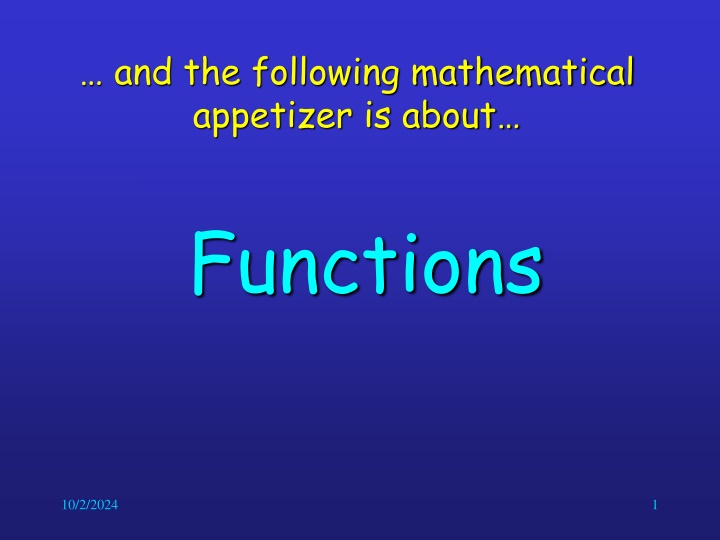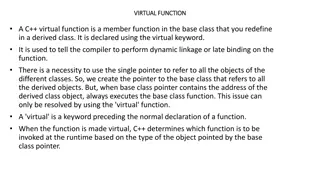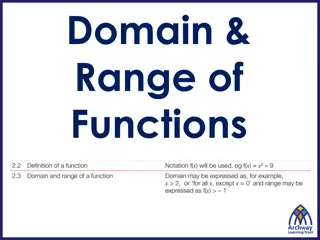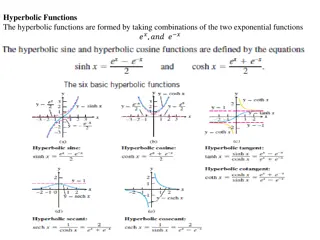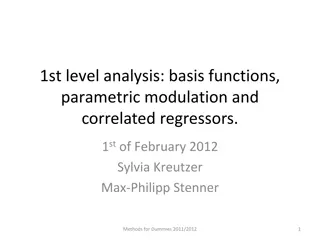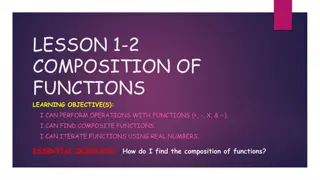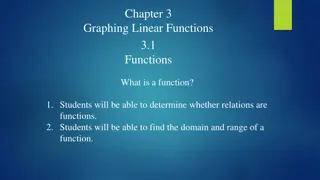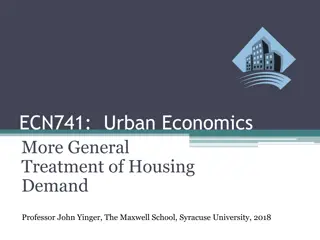Functions: Basics and Examples
Functions play a crucial role in mathematics, mapping elements from one set to another. This appetizer delves into the fundamentals of functions, discussing domains, codomains, images, pre-images, and ranges. Through examples and illustrations, learn how functions work, how to represent them, and how operations like sum and product of functions are defined.
Download Presentation

Please find below an Image/Link to download the presentation.
The content on the website is provided AS IS for your information and personal use only. It may not be sold, licensed, or shared on other websites without obtaining consent from the author.If you encounter any issues during the download, it is possible that the publisher has removed the file from their server.
You are allowed to download the files provided on this website for personal or commercial use, subject to the condition that they are used lawfully. All files are the property of their respective owners.
The content on the website is provided AS IS for your information and personal use only. It may not be sold, licensed, or shared on other websites without obtaining consent from the author.
E N D
Presentation Transcript
and the following mathematical appetizer is about Functions 10/2/2024 1
Functions A function f from a set A to a set B is an assignment of exactly one element of B to each element of A. We write f(a) = b if b is the unique element of B assigned by the function f to the element a of A. If f is a function from A to B, we write f: A B (note: Here, has nothing to do with if then) 10/2/2024 2
Functions If f:A B, we say that A is the domain of f and B is the codomain of f. If f(a) = b, we say that b is the image of a and a is the pre-image of b. The range of f:A B is the set of all images of elements of A. We say that f:A B maps A to B. 10/2/2024 3
Functions Let us take a look at the function f:P C with P = {Linda, Max, Kathy, Peter} C = {Boston, New York, Hong Kong, Moscow} f(Linda) = Moscow f(Max) = Boston f(Kathy) = Hong Kong f(Peter) = New York Here, the range of f is C. 10/2/2024 4
Functions Let us re-specify f as follows: f(Linda) = Moscow f(Max) = Boston f(Kathy) = Hong Kong f(Peter) = Boston Is f still a function? yes What is its range? {Moscow, Boston, Hong Kong} 10/2/2024 5
Functions Other ways to represent f: x f(x) Linda Boston Linda Moscow Max New York Max Boston Kathy Hong Kong Hong Kong Kathy Peter Moscow Peter Boston 10/2/2024 6
Functions If the domain of our function f is large, it is convenient to specify f with a formula, e.g.: f:R R f(x) = 2x This leads to: f(1) = 2 f(3) = 6 f(-3) = -6 10/2/2024 7
Functions Let f1 and f2 be functions from A to R. Then the sum and the product of f1 and f2 are also functions from A to R defined by: (f1 + f2)(x) = f1(x) + f2(x) (f1f2)(x) = f1(x) f2(x) Example: f1(x) = 3x, f2(x) = x + 5 (f1 + f2)(x) = f1(x) + f2(x) = 3x + x + 5 = 4x + 5 (f1f2)(x) = f1(x) f2(x) = 3x (x + 5) = 3x2 + 15x 10/2/2024 8
Functions We already know that the range of a function f:A B is the set of all images of elements a A. If we only regard a subset S A, the set of all images of elements s S is called the image of S. We denote the image of S by f(S): f(S) = {f(s) | s S} 10/2/2024 9
Functions Let us look at the following well-known function: f(Linda) = Moscow f(Max) = Boston f(Kathy) = Hong Kong f(Peter) = Boston What is the image of S = {Linda, Max} ? f(S) = {Moscow, Boston} What is the image of S = {Max, Peter} ? f(S) = {Boston} 10/2/2024 10
Properties of Functions A function f:A B is said to be one-to-one (or injective), if and only if x, y A (f(x) = f(y) x = y) In other words: f is one-to-one if and only if it does not map two distinct elements of A onto the same element of B. 10/2/2024 11
Properties of Functions And again f(Linda) = Moscow f(Max) = Boston f(Kathy) = Hong Kong f(Peter) = Boston g(Linda) = Moscow g(Max) = Boston g(Kathy) = Hong Kong g(Peter) = New York Is f one-to-one? Is g one-to-one? No, Max and Peter are mapped onto the same element of the image. Yes, each element is assigned a unique element of the image. 10/2/2024 12
Properties of Functions How can we prove that a function f is one-to-one? Whenever you want to prove something, first take a look at the relevant definition(s): x, y A (f(x) = f(y) x = y) Example: f:R R f(x) = x2 Disproof by counterexample: f(3) = f(-3), but 3 -3, so f is not one-to-one. 10/2/2024 13
Properties of Functions and yet another example: f:R R f(x) = 3x One-to-one: x, y A (f(x) = f(y) x = y) To show: f(x) f(y) whenever x y x y 3x 3y f(x) f(y), so if x y, then f(x) f(y), that is, f is one-to-one. 10/2/2024 14
Properties of Functions A function f:A B with A,B R is called strictly increasing, if x,y A (x < y f(x) < f(y)), and strictly decreasing, if x,y A (x < y f(x) > f(y)). Obviously, a function that is either strictly increasing or strictly decreasing is one-to-one. 10/2/2024 15
Properties of Functions A function f:A B is called onto, or surjective, if and only if for every element b B there is an element a A with f(a) = b. In other words, f is onto if and only if its range is its entire codomain. A function f: A B is a one-to-one correspondence, or a bijection, if and only if it is both one-to-one and onto. Obviously, if f is a bijection and A and B are finite sets, then |A| = |B|. 10/2/2024 16
Properties of Functions Examples: In the following examples, we use the arrow representation to illustrate functions f:A B. In each example, the complete sets A and B are shown. 10/2/2024 17
Properties of Functions Linda Boston Is f injective? No. Is f surjective? No. Is f bijective? No. Max New York Kathy Hong Kong Peter Moscow 10/2/2024 18
Properties of Functions Linda Boston Is f injective? No. Is f surjective? Yes. Is f bijective? No. Max New York Kathy Hong Kong Peter Moscow Paul 10/2/2024 19
Properties of Functions Linda Boston Is f injective? Yes. Is f surjective? No. Is f bijective? No. Max New York Kathy Hong Kong Peter Moscow L beck 10/2/2024 20
Properties of Functions Linda Boston Is f injective? No! f is not even a function! Max New York Kathy Hong Kong Peter Moscow L beck 10/2/2024 21
Properties of Functions Linda Boston Is f injective? Yes. Is f surjective? Yes. Is f bijective? Yes. Max New York Kathy Hong Kong Peter Moscow Helena L beck 10/2/2024 22
Inversion An interesting property of bijections is that they have an inverse function. The inverse function of the bijection f:A B is the function f-1:B A with f-1(b) = a whenever f(a) = b. 10/2/2024 23
Inversion Example: The inverse function f-1 is given by: f-1(Moscow) = Linda f-1(Boston) = Max f-1(Hong Kong) = Kathy f-1(L beck) = Peter f-1(New York) = Helena f(Linda) = Moscow f(Max) = Boston f(Kathy) = Hong Kong f(Peter) = L beck f(Helena) = New York Inversion is only possible for bijections (= invertible functions) Clearly, f is bijective. 10/2/2024 24
Inversion Linda Boston f Max New York f-1 f-1:C P is no function, because it is not defined for all elements of C and assigns two images to the pre- image New York. Kathy Hong Kong Peter Moscow Helena L beck 10/2/2024 25
Composition The composition of two functions g:A B and f:B C, denoted by f g, is defined by (f g)(a) = f(g(a)) This means that first, function g is applied to element a A, mapping it onto an element of B, then, function f is applied to this element of B, mapping it onto an element of C. Therefore, the composite function maps from A to C. 10/2/2024 26
Composition Example: f(x) = 7x 4, g(x) = 3x, f:R R, g:R R (f g)(5) = f(g(5)) = f(15) = 105 4 = 101 (f g)(x) = f(g(x)) = f(3x) = 21x - 4 10/2/2024 27
Composition Composition of a function and its inverse: (f-1 f)(x) = f-1(f(x)) = x The composition of a function and its inverse is the identity function i(x) = x. 10/2/2024 28
Graphs The graph of a function f:A B is the set of ordered pairs {(a, b) | a A and f(a) = b}. The graph is a subset of A B that can be used to visualize f in a two-dimensional coordinate system. 10/2/2024 29
Floor and Ceiling Functions The floor and ceiling functions map the real numbers onto the integers (R Z). The floor function assigns to r R the largest z Z with z r, denoted by r . Examples: 2.3 = 2, 2 = 2, 0.5 = 0, -3.5 = -4 The ceiling function assigns to r R the smallest z Z with z r, denoted by r . Examples: 2.3 = 3, 2 = 2, 0.5 = 1, -3.5 = -3 10/2/2024 30
